Preserving Peru's Textile Tradition
Awarding the Artistry of Weavers
Article & Photos By Jim
Kane
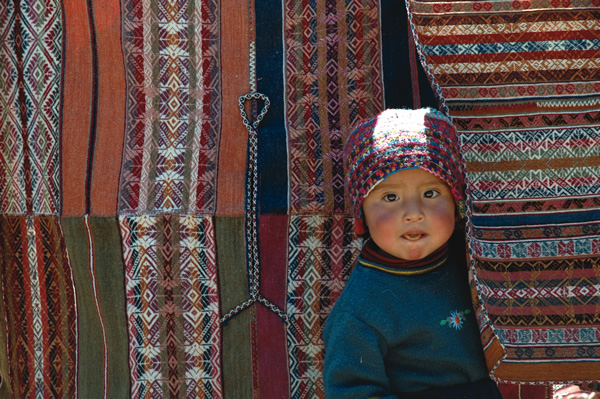
|
|
A young admirer of weavings (and pretzels) peeks into the competition through his mother's entries.
|
Damian and I were reconnecting after more than two years to celebrate the first annual Culture Xplorers' Weavers Awards in conjunction with the nonprofit Center
for Traditional Textiles of Cusco (CTTC). We originally met during an exploratory visit to Peru in 2003 when, in the company of Nilda Callanaupa — CTTC's founder and the person most responsible for the revival of Peru's textile
tradition in recent years — we drove two hours from Cusco to the hamlet of Chahuatire to spend a day with the weavers and farmers who live there and learn firsthand about their traditions.
During that visit we hiked in the surrounding hills and talked about life in their remote village of 120 families: the farming, weaving, festivals, open spaces, and the sense of a tightly-knit community. Weaving generated
the critical income that allowed Damian's family and others to subsist after Peru's potato crisis.
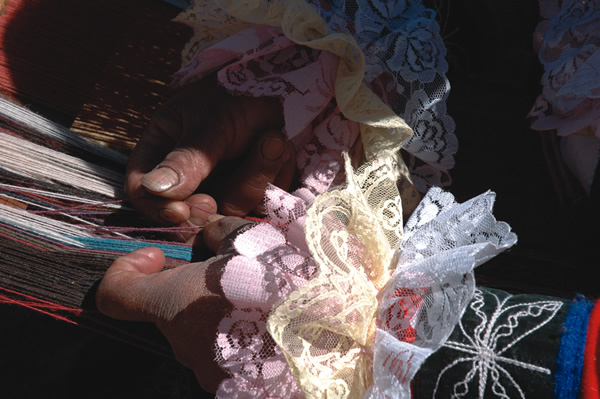
|
|
The hands of a weaver in action.
|
The idea for the Weavers Awards came from our conversation that day. An award to celebrate the skills of the weavers and to provide them with a financial incentive to continue to increase the quality of their spectacular
art seemed like something that both weavers and travelers would rally behind.
When I went to Nilda with my idea she was eager to help bring the competition to life, and we began planning for the first awards celebration to be held in July 2005. Twenty-one top weavers (and one in a separate youth
category), representing six communities, came together in Chinchero to be honored with medals, framed certificates, and a share of the $1,000 cash prize.
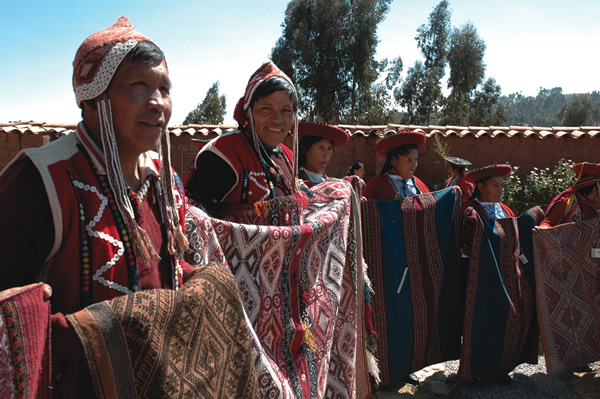
|
|
Weavers from six Andean communities proudly display their winning entries for the first annual Culture Xplorers' Weavers Awards celebrated in Chinchero, Peru in 2005.
|
An Emotional Impact
While CTTC has recognized and cultivated the value of the weavers' art over the past 20 years, very few of the cooperative's weavers ever get to interact with the foreigners who appreciate and value their art. This
event marked the first time that all six communities' most skilled weavers were celebrated among a large audience of their peers and foreigners, and the first time that they received awards.
Ben Goodman, a graphic designer from Philadelphia, and one of several clients who joined us for this inaugural event, says, "It's one thing to be excited about meeting the people of an indigenous community. But it's
infinitely greater to be invited to appreciate their living traditions through an event of this kind. For weeks I practiced what I would say when I finally met them."
The emotional impact the ceremony had on both weavers and travelers alike was even greater than I had imagined. Heartfelt speeches, hugs, and hearty congratulations were shared with smiles and a few moist eyes. Nicolas,
the 1st place winner from Chahuatire, was silent, looking down fondly at the gold medal he held in his right hand and the certificate grasped in his left.
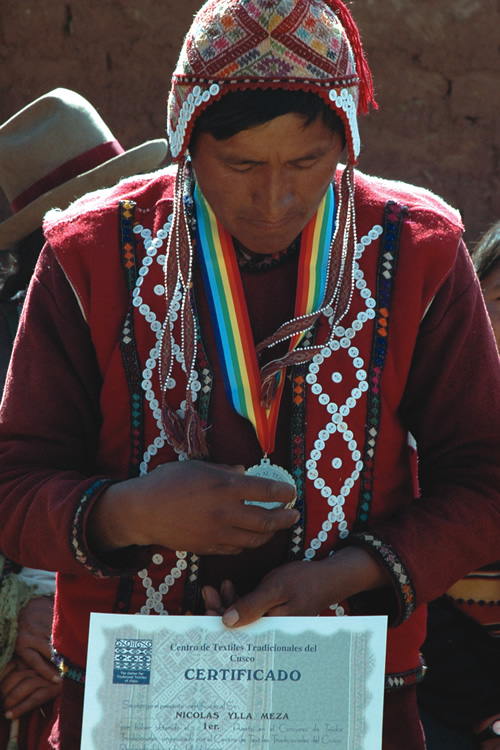
|
|
Nicolas Ylla Meza, of the Chahuatire community, savors the moment after winning 1st place.
|
A Very Serious Event
The following morning Nilda and I met at the hotel to reflect on these first awards and to look ahead toward next year. "It was something special that they'll never forget, I'll never forget. But we've also made
an important commitment to the weavers. We've raised their hopes and their expectations . . . It's going to be a very serious event."
She went on to tell a story about the 2nd place winner from Chinchero. "For many years, she has been abused by her husband, who always claimed she was lazy. Since joining the association two years ago she can open
her mouth, she can make jokes. Her children are much happier. I think she even got respect from her husband. I'm so happy to see how self-esteem goes up when you have the opportunity to be with people who appreciate your work."
These words from Nilda echoed in my head as we drove toward Lampa later that morning. The first-time travelers to Peru who accompanied me not only had a chance to meet the weavers of the Sacred Valley in a respectful
and personal way but also to learn about and support their art and ancient traditions.
It struck me that these awards may be used as a model for other responsible tourism collaborations around the globe to build sustainable bridges between cultures. The awards celebrate people and traditions and encourage
them by creating not only economic incentives but also self-esteem in the artists and pride in the local culture. They bring travelers and locals together in an atmosphere of mutual respect and offer a real reciprocity — something
is given as well as received by all participants.
Wendy, a jewelry designer who lives in Sarasota, offered her perspective on the event: "As an artist, I was overcome with emotions the moment I saw the look of pure gratitude on the weavers' faces upon our arrival.
When the men and women gathered to form a line and greet us with warm handshakes, kisses, and hugs I knew this was going to be a truly unique event. What struck me was the weavers' immense pride and their passion for their craft. They
were not just making art to get into a show or to build a resume. It was something deeper. Their art is at the core of their society, and creating it carries on the family tradition and cultural heritage. Being part of this inspired me
with a deeper motivation than any award will ever give me."
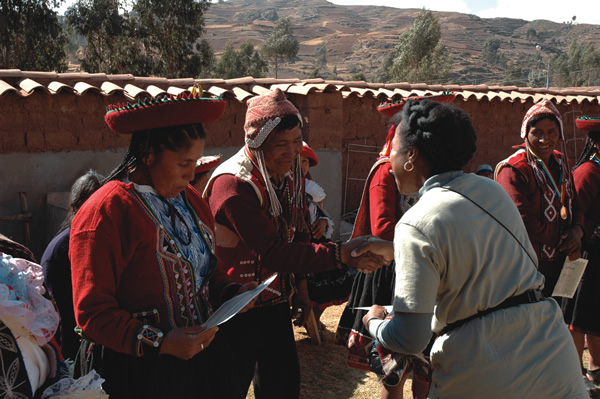
|
|
Culture Xplorers traveler Annette Beatty awards one of the 21 certificates given to winning weavers.
|
JIM KANE has written
frequently for Transitions Abroad on travel with a community-based
emphasis. He is the founder and CEO of award-winning Culture
Xplorers, a recognized leader in sustainable travel.
|
